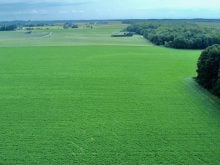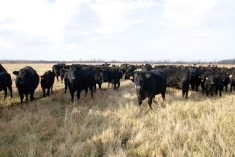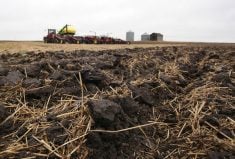Southern Alberta agronomist and author Scott Gillespie believes there is a world where organic and conventional farming can meet in the middle and be beneficial to both.
It’s why he wrote Practical Regeneration: Realistic Strategies for Climate Smart Agriculture.
“The main thing was going to all these conferences of just amazing results from practices. It was, I call them, ‘celebrity farmers,’ it’s not even research scientists or policy makers, it’s people who have fairly extraordinary claims of those things are working,” said Gillespie, who has nearly two decades of experience in dryland and irrigated specialty crop agriculture.
Read Also

U.S. bill could keep out Canadian truckers
The Protecting America’s Roads Act, which was tabled in the U.S. House of Representatives at the beginning of October, would “rid the country of illegal immigrant commercial truck drivers and ineligible foreign nationals.”
“A lot of the point of the book is first of all having things that are economical that make sense for farmers to do. You shouldn’t do something just because it’s a principle, because someone says it does something.”
Gillespie said more efficient use of inputs is an area where farmers could make improvements with further research on best practices, although he acknowledges they have already made great strides.
“Realistically, when you look at western Canadian production compared to a lot of other areas in the world, we use a lot less fertilizer and we all are mostly no till. The big things that are going to help, we are already there comparatively (to other nations),” said Gillespie.
“Even broadcasting fertilizer, banding it or placing it right physically into the soil, that is already happening. In some ways, they are already further ahead in Western Canada, and we can keep going forward. Comparing it to even 20 years ago, we are using more nitrogen fertilizer, but our yields are higher. If you look at use per bushel, we are getting more efficient. Just because of the climate being drier, we don’t use as much fertilizer as other areas do. A big one, I think, we can do is improving mapping with precise rates for different zones in the field.”
He said agronomists combine the science of growing crops with enhancing the soil and then advise farmers when they have questions about either.
His podcast, Plants Dig Soil, focuses on scientifically proven practices that benefit the planet and provide for farmers’ economic sustainability.
His book has 24 chapters that touch on such topics as defining regenerative agriculture, a long view of regeneration, return on investment, evaluating products, full season cover, when rains don’t come, strategic tillage for soil health and selling and using carbon as a tool.
“The last half of the book is talking about carbon sequestration programs which are a little bit different. They are talking about paying farmers to put carbon into the soil. My opinion is you can’t just put carbon into the soil. It’s a system; you can put more in, but it activates it,” said Gillespie.
“They will talk about being more regenerative, getting your soil working for you. A better functioning soil is more biologically active, so if you put more into it, more comes out of it in terms of carbon dioxide, so it doesn’t change things a whole lot.”
In the days of climate-change anxiety, Gillespie has seen people choose agricultural systems that seem right on the surface but don’t make a noticeable difference.
His book starts with the broad strokes of what Gillespie has learned in his own personal garden.
Gardening was a hobby growing up on a farm in southern Ontario, and that love of the land blossomed into a life-long journey in agriculture.
He attended the University of Guelph, where he earned a BSc in agriculture before pursuing his MSc in plant science at the University of Manitoba. Gillespie has a professional designation (P.Ag) from the Alberta Institute of Agrologists and has also attained Certified Crop Advisor (CCA) status from the American Society of Agronomy.
The book then shifts to how farmers can get practical in implementing the main healthy-soil practices, such as cover crops and intercropping. It then segues into how farmers can advance their practices above the basics, concluding by looking into the future and examining how farmers can look at profitability in the long term.
“A lot of it came down to me doing my own investigation, science wise. Looking for published reports, things written by scientists or third-party trials on things where they test out the practice or the product,” said Gillespie.
“All the new products coming out, the biologicals being a big one, they don’t have third-party data, they have testimonials and internal trials. Well, you can’t trust those. They can give an indication, though.”
Gillespie, who runs an agronomy business, Plants Dig Soil Consulting Ltd., says his book focuses on southern Alberta but can also be applicable to other regions.
“It has helped people find out more about how I think, and then when they need consulting work, whether it’s farmers or organizations that need help wading through stuff, I have had a few who have directly told me they read the book and now they are coming to me,” said Gillespie.
The book has been read in the Netherlands, Australia and the United States, he added.
Gillespie said many of the farming practices followed on the Prairies improve soil health, even though that’s not producers’ main motivation. For example, he said he keeps hearing about increased use of stripper headers, which leave taller residue on the land. Technically, the practice follows the soil health principle of leaving more armour on the soil.
“But they are not doing it because it’s a soil health principle; they are doing it because they are trapping a little bit more snow, and it’s making for a bit better micro climate for the plants. The wind is not as hard on them, and it’s not quite as hot, it’s not as harsh down there,” said Gillespie.
“It’s little adaptations that add up over time. It’s a long-distance race.”

















